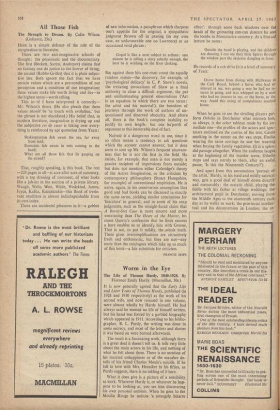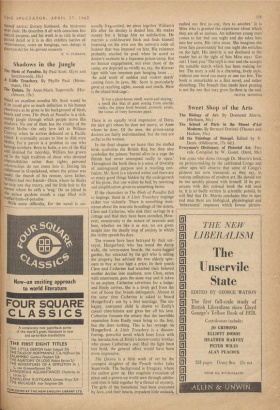Worm in the Eye
IT is now generally agreed that the Early Life and Later Years of Thomas Hardy, published (in 1928 and 1930 respectively) as the work of his second wife, and now reissued in one volume, were almost wholly by Hardy himself. He had always said he wanted no life of himself written, but his hand was forced by a garbled biography which appeared in 1911. According to his biblio- grapher, R. L. Purdy, the writing was done in some secrecy, and most of the letters and diaries it was based on were burned afterwards.
The result is a fascinating work, although there is a great deal it doesn't tell us. It tells very little about the main actors in his life, and nothing of what he felt about them. There is no mention of his married unhappiness or of the macabre de- tails of his friend Charles Moule's suicide. If he tell in love with Mrs. Henniker in his fifties, as Purdy suggests, there is no inkling of it here.
What it does give is a picture of a sensibility at work. Wherever Hardy is, or whatever he hap- pens to be looking at, you see him discovering his own personal emblem. When he goes to the Moulin Rouge he notices 'a strangely bizarre
effect': through some back windows over the heads of the grimacing can-can dancers he sees the tombs in Montmartre cemetery. At a first-aid, lecture he notes:
Outside the band is playing, and the children are dancing. I can see their little figures through the window past the skeleton dangling in front.
He records of a cab drive (it is a kind of summary of Tess):
Drove home from dining with Mcllvaine at the Café Royal, behind a horse who had no interest in me, was going a way he had no in- terest in going, and was whipped on by a man who had no interest in me, or the horse, or the way. Amid this string of compulsions reached home.
When he goes to see the strolling players per- form Othello in Dorchester what interests him, as always, is the other tableau made by the im- mediate one—the profiles of the actors and spec- tators outlined on the canvas of the tent, Cassio smoking in the sunset on the van steps, Emilia wearing the same earrings he saw her wearing when buying the family vegetables. (It is a splen- did passage altogether. When the audience laughs, at the beginning of the murder scene, Othello, stops and says sternly to them, after an awful, pause, 'Is this the Nineteenth Century?') And apart from this unconscious 'portrait of the artist,' Hardy, in his staid and mildly satirical way, gets a good deal of himself down directly and memorably: the ecstatic child, playing the fiddle with his father at village weddings; the' architectural pupil in Dorchester, moving from the Middle Ages to the nineteenth century each day as he walks to work; the provincial intellec- tual and his deconversion in London; the re- turned native; literary lionhood; the bitterness Over Jude. He describes it all with conscious his- torical purpose, and his work is as rich in exact Period detail as it is in dire exhibits (satires of circumstance, notes on hangings, rum doings in graveyards) for his private museum.,
P. N. PURBANK















































 Previous page
Previous page